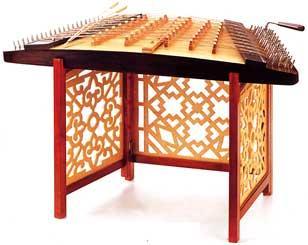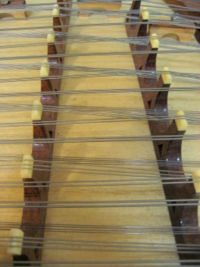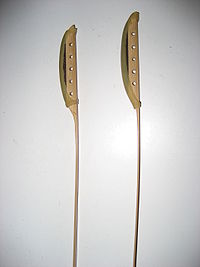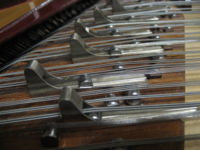yangqin

The trapezoidal yangqin is a Chinese hammered dulcimer originally from the Middle East (Persia (modern-day Iran)).The instruments are also sometimes known by the names "santur" and "cymbalom".
The yangqin was traditionally fitted with bronze strings , which gave the instrument a soft timbre. This form of instrument is still occasionally heard today in the hudie qin (蝴蝶琴, lit. "butterfly zither") played in the traditional silk and bamboo genre from the Shanghai region known as Jiangnan sizhu (江南绿竹), as well as in some Cantonese music groups. Since the 1950s, however, steel alloy strings (in conjunction with copper-wound steel strings for the bass notes) have been used, in order to give the instrument a brighter, and louder tone. The modern yangqin can have as many as five courses of bridges and may be arranged chromatically. Traditional instruments, with three or more courses of bridges, are also still widely in use. The instrument's strings are struck with two lightweight bamboo beaters (also known as hammers) with rubber tips. A professional musician often carries several sets of beaters, each of which draws a slightly different tone from the instrument.
The yangqin is used both as a solo instrument and in ensembles. Composer/vocalist Lisa Gerrard has used this instrument in the 8 albums recorded by the band Dead Can Dance and also in some of her performances solo since the break up of Dead Can Dance. The Chinese music women artists group Twelve Girls Band has also used this instrument in more than 17 albums and other performances. They are famous for using traditional Chinese music instruments to play Western popular music, including songs from Coldplay and Enya.
As the yangqin is a type of hammered dulcimer, it shares many elements of construction with other instruments in the hammered dulcimer family:
Strings
Bridges and strings of a yangqin. This particular image is of the lower strings, which are thicker and wound with copper.
Modern yangqin usually have 144 strings in total, with each pitch running in courses, with up to 5 strings per course, in order to boost the volume. The strings come in various thicknesses, and are tied at one end by screws, and at the other with tuning pegs. The pegs and screws are covered during playing by a hinged panel/board. This panel is opened up during tuning to access the tuning pegs.
Bridges
There are usually four to five bridges on a yangqin. From right to left, they are: bass bridge, "right bridge", tenor bridge, "left bridge", and the chromatic bridge. During playing, one is supposed to strike the strings on the left side of the bridges. However, the strings on the "chromatic bridge" are struck on the right, and strings on the "left bridge" can be struck on both sides of the bridge.
Hammers
The bodies of a pair of yangqin hammers. The pointed ends of the sticks are used to pluck strings, producing a crisp, clear tone.
The hammers are made of flexible bamboo, and one end is half covered by rubber. Due to their unique construction, there are two ways to play: with the rubber side for a softer sound, and with the bamboo side for a crisper, more percussive sound. This technique, known as 反竹 (fǎnzhǔ), is best utilized in the higher ranges of the yangqin. Additionally, the ends of the sticks can be used to pluck the strings, producing a sharp, clear sound. Glissandos can also be achieved in this way by running the ends of the sticks up or down the strings.
Furthermore, some songs require the use of "双音琴竹" (shuāng yīn qín zhǔ), literally "double-note yangqin hammers". These specially-constructed hammers have 2 striking surfaces, allowing the player to play up to 4 notes simultaneously (or even 8 notes, if the strings of the "left bridge" and "tenor bridge" are struck at a point where they intersect each other), resulting in a rich, powerful tone, which is especially pronounced in the lower registers due to the strings' long echoes. 林冲夜奔 (Lin Chong Flees In The Night), composed by 项祖华 (Xiang Zu Hua), is a representative solo piece which utilizes 双音琴竹.
When using 双音琴竹, the left hand holds a beater that plays intervals of a perfect fourth, while the right hand's beater plays thirds. These intervals are standard over most of the yangqin's range, due to the positioning of its strings.
Cylindrical nuts
Cylindrical nuts, fitted into fine-tuning devices.
On both sides of the yangqin, aside from the tuning screws, are numerous cylindrical metal Nuts that can be moved for fine tuning the strings or to raise the strings slightly to eliminate unwanted vibrations that may occur. More modern designs also have moveable ball-shaped nuts that can be adjusted on the fly with the fingers; this provides some microtuning and additional dynamics during performances, such as portamentos and vibratos (see below: "Manner of Performance").
Selected repertoire
Solo pieces
- Joyous News (喜讯)
- Three-Six (弹词三六)
- Song of the Border (边寨之歌)
- Opening the Well of Happiness with Our Hands (双手开出幸福泉)
- Spring Arrives at the Qing River (春到清江)
- Thunder During a Drought (旱天雷)
- Dragon Boat (龙船)
- Festive Tianshan (节日的天山)
- The General's Command (将军令)
- The Red Flower (映山红)
- Seagull (海燕)
- Beautiful Africa (美丽的非洲)
- Hand-Waving Dance of the Tu Tribe (土家摆手舞曲)
- Green Bamboo Forest (竹林涌翠)
- Lin Chong Flees in the Night (林冲夜奔)
Concertos
- Ya Lu Zang Bu Riverside (雅鲁藏布江边)
- Romance of the Yellow Earth (黄土情)
- Memory (忆事曲)
- The Phoenix (凤点头)
- Ocean Gorge Symphonic Poem (海峡音诗)
- Manchu Countryside Capriccio (金翎思-满乡随想)
- Yellow River (黄河随想曲)



